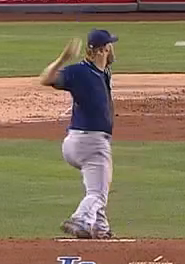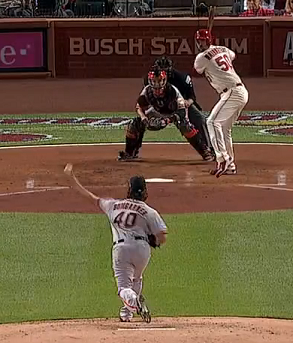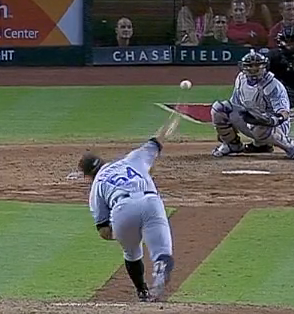The last episode of Raising Aces tackled the pitchers with the best (and worst) mechanics in the American League West, and this week we jump across leagues to highlight the outlier deliveries in the West Division of the National League.
The top end of the scale is dominated by the World Series Champion Giants, and though it might be tempting to view this as a knee-jerk reaction to the recent success of the ballclub, the pitchers at the top of the scale have achieved top scores in their respective categories for the last few years. It is extremely rare for a pitcher to have any 80-grade attribute, and the fact that San Francisco has three different pitchers who score an 80 is as intriguing as the fact that these ceiling-breaking marks occur in three distinct categories. Rather than attempt to pour these very different pitchers into a similar mold for success, the Giants have allowed their arms to retain the characteristics of signature while adjusting to their own unique circumstances.
Perhaps equally glaring is the absence of Clayton Kershaw from any of these categories, though Kershaw had to overcome many of the obstacles inherent in his own delivery in order to realize his ultimate success.
Pitchers must clear a couple of thresholds in order to receive consideration for these “awards”: 1) must have pitched 40 or more innings in the majors in 2014; and 2) must have finished the season playing for one of the five clubs in the NL West.
Without further ado, let's take a look at the extreme mechanics of the NL West.
Balance
Best: Matt Cain, 80 grade
Cain has one of the most stable deliveries in baseball, and he maintains ideal balance from first movement through foot strike. There were times this past season where his balance slipped to a merely elite grade of 70, with a slight lean toward the first-base side and some late tilt, but Cain has maintained some of the best balance in the majors over the past few years. His vertical balance is the definition of 80-grade, with his center-of-gravity staying consistent with the slope of the mound. At peak, his lateral stability stays true with the target, and even when he drifts offline the veer is minimal. Cain also maintains balance in the Z plane (rubber to home plate), with no rock-n-roll or back-side collapse while keeping his head stable through release point without finishing too far out in front. The right-hander might have the best balance in the game, and though fellow NL West starters such as Tyson Ross, Madison Bumgarner, and Ian Kennedy deserve a hat-tip for their stability, Cain takes the division crown.
Worst: Randall Delgado, 35 grade
Overall, the pitchers of the NL West are a well-balanced group. Whether looking at starters or relievers, there are very few examples in the division of poor coordination, and Delgado stands out for his lack of stability throughout the motion. His grade for balance is volatile, varying from start to start between a 30-grade and a 40-grade due to inconsistencies in his Y-plane (vertical) and X-plane (lateral) balance. The net result is a 35 grade for balance, as Delgado lacks stability throughout the entire delivery. He has a heavy drop after maximum leg lift, marking the first checkpoint in a delivery that has distinct phases, and he also incorporates a lean to the first-base side throughout his motion that begins drifting early and continues to worsen through release point.
Momentum
Best: Tim Lincecum, 80 grade
Lincecum has been the model for 80-grade momentum for years, reaping the advantage of a deeper release point while generating heavy kinetic energy with his lower half. Lincecum can repeat his burst when he is in peak form, but he has struggled to coordinate his timing over the past couple of seasons as he ventures further from his physical peak, and it is common to see him overcompensate with adjustments to his momentum when timing falls off track. The struggles have raised questions about everything from his diet to his conditioning as the hardware-toting right-hander of his youth has given way to the volatile pitcher that we have seen over the past few seasons.
Repetition of timing is paramount to sheer momentum in the hierarchy of the kinetic chain, but these elements are naturally interconnected, as a pitcher's pace to the plate will launch his timing pattern for the rest of the delivery. Momentum is somewhat unique among the grades for this reason, and though many pitchers could improve their timing consistency by getting a bigger charge to the plate, Lincecum exemplifies the potential downfalls associated with being too fast for the body to stay in control. He is exceptionally fast when pitching from both the windup and stretch, and an advantage of the powerful momentum is that Lincecum has no need for a slide step when pitching with runners on base.
Worst: Dan Haren, 30 grade
Haren is a blatant example of the phrase “stop at the top,” halting his momentum at max leg lift before gathering his energy to propel toward the target. The dramatic pause is akin to many pitchers who come across the Pacific Ocean from Nippon Professional Baseball, where the exaggerated stop-at-the-top is common in an effort to stabilize the pitcher's balance halfway through the delivery. Such a slow transition makes it easy to see the individual gears in Haren's momentum, and though some of the pitchers who feature the “NPB pause” are able to achieve above-average grades for momentum due to the sheer magnitude of that second gear, Haren's motion stays on the slow side whether considering the various speeds individually or grading the delivery in its entirety. He does get a bit of momentum going just before foot strike, saving the right-hander from a bottom-feeding score on the 20-80 scale, but the deliberate pace of his windup forms a stark contrast to the quicker needs of pitching from the stretch.
Torque
Best: Andrew Cashner, 70 grade
Cashner has the ability to hit the upper 90s with his fastball, and he will also sacrifice a little velo in order to generate some arm-side boring action on his heater. At the root of his impressive radar gun readings is double-plus torque that fuels elite arm speed, though the instant of maximum hip-shoulder separation is fleeting and can be easy to miss when watching him pitch at full speed. His torque is very heavy on the hips, with a strong delay to his trigger such that his belt buckle is already facing a right-handed batter before the upper half fires. Cashner adds a small upper-body twist and some scapular load to further raise the grade, giving him the torque to lead the division in average velocity despite his saving some bullets in order to endure a starter's workload.

Worst: Paul Maholm, 30 grade
Maholm has a pitching motion that is extremely light on power. He features a slow pace of momentum, but the most glaring power failure lies in the lack of torque in his delivery. Maholm waits until very late in the kinetic sequence to begin rotating the hips, firing his lower half just before foot strike, but there is no concurrent delay to his upper-body rotation, such that his hips and shoulders fire in near unison. The inefficient hip-whip strategy is the culprit behind his relatively pedestrian pitch speeds.

Posture
Best: Madison Bumgarner, 80 grade
The posture category is the “easiest” for a pitcher to register an 80 grade, as there is an absolute ceiling to one's ability to maintain his head above the center-of-mass at release point, whereas the other baseline scores have an invisible ceiling of improvement. That is to take nothing away from Bumgarner, who executes perfect posture with incredible consistency, and who has some of the best overall stability in the game. The rest of the division fell considerably short of his leading score in the posture department, with the next-closest marks falling in the 60-65 range, including pitchers such as Ian Kennedy, Sergio Romo, and much of the bullpen for the L.A. Dodgers.

Worst: Tommy Kahnle, 30 grade
There are two common instigators of spine-tilt: 1) poor balance with a weak foundation, and 2) a blatant lean to the glove-side as a pitcher attempts to manipulate a higher arm slot. Kahnle mixes both ingredients in his recipe for 30-grade posture, with shaky balance during the stride phase followed by a sudden veer with his head to the glove-side as the throwing arm comes through during the highest-intensity portion of the delivery. His plus torque ups the degree of difficulty for the right-hander to find a position that is square to the target, and he appears to lack the functional strength and flexibility to sustain stability during this powerful phase of his delivery.

Overall
Best: Bumgarner, A grade
Bumgarner receives a straight-A for his mechanics, one of just a handful of pitchers who can make such a claim. Unlike some of the other “A” students, Bumgarner does have a below average score on his report card in the form of sub-par momentum, but his other scores are so high that they drown out the downside of his slower pace to the plate, and the fact that he can repeat that time signature with such regularity indicates that it could be detrimental to his effectiveness to attempt to coax some extra momentum out of his delivery. His balance is almost as strong as his 80-grade posture, and the southpaw is able to avoid spine-tilt at the end of his delivery in large part because of the stability, repetition, and positioning for the preceding links of the kinetic chain. Bummer weaves all of these elements into a finely-tuned machine of mechanical efficiency, a trait that was descriptive of his delivery long before he announced his presence with authority on the national stage during the past postseason—Bumgarner received high marks for his motion in each of the past two Starting Pitching Guides, and he will earn an “A” in the 2015 SP Guide as well.
Thank you for reading
This is a free article. If you enjoyed it, consider subscribing to Baseball Prospectus. Subscriptions support ongoing public baseball research and analysis in an increasingly proprietary environment.
Subscribe now
The "across the body" terminology is often used as a blanket to describe any closed-striding pitcher (which Bumgarner is), but the key is whether that pitcher can get square to the target, and the relationship between hip-angle and shoulder-angle (at release point) is part of a pitcher's signature. One can test this by having the athlete play catch from his knees and toying with the setup angle of the hips/knees - pitchers who setup too closed will indeed throw across the body in this drill, but the ideal angle is dependent on the player.
In the case of Bumgarner, his signature dictates a somewhat closed stride, but he requires that angle in order to be square to the target. For this reason, I am unconcerned with Bummer's angle, and in fact a more standard angle would leave him open at release point. The ability to find an ideal release point is not reflected in the four grades covered in this article, but it is a component of timing and repetition, and it is definitely something that I consider when evaluating a player. I just don't subscribe to the theory that all closed-striding pitchers throw across the body.
Interestingly, left-handers in particular tend to get wedged into an unnaturally closed stride in order to create angle, and Bumgarner's is nowhere near extreme when considering other southpaws.
Thanks for the kind words as well as the thoughtful question.